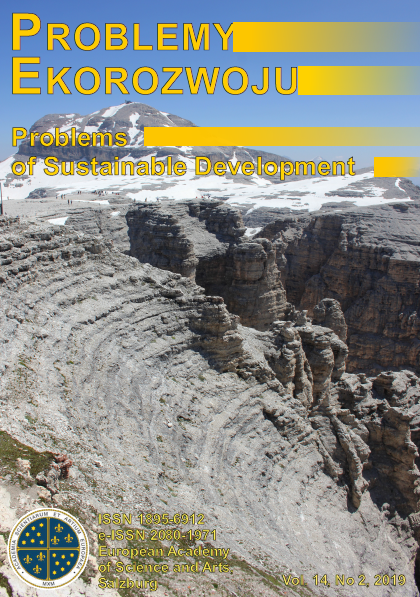ADAMIŠIN P., VAVREK R., and PUKALA R., 2015, Cluster Analysis of Central and Southeast Europe via Selected Indicators of Sustainable Development, in: Environmental Economics, Education and Accreditation in Geosciences: Ecology, Economics, Education and Legislation.
(Conference Proceedings: 15th International Multidisciplinary Scientific Geoconference, Sofia (SGEM 2015), 3, p. 135-140.
ALDENDERFER M., BLASHFIELD R., 1984, Cluster analysis, Sage Publications, Beverly Hills.
ALLIEVI, F., LUUKKANEN, J., PANULAONTTO, J., VEHMAS, J., 2011, Grouping and Ranking the EU-27 Countries by their Sustainability Performance Measured by the Eurostat Sustainability Indicators, in: Proceedings of the Conference ‘Trends and Future of Sustainable Development. 9-10 June 2011, eds. Lakkala, H. and Vehmas, J., Tampere, Finland. Turku: Finland Futures Research Centre, pp. 9-20.
DREXHAGE J., MURPHY D., 2010, Sustainable Development: From Brundtland to Rio 2012, International Institute for Sustainable Development (IISD), New York.
DRASTICHOVÁ M., 2018a, Sustainability of the EU Countries Measured by Selected Approaches, in: Proceedings of the 4th International Conference on European Integration 2018.
DRASTICHOVÁ, M., 2018b. The Theory and Measurement of Sustainable Development, in: SAEI, 52, VSB-TU Ostrava, Ostrava.
DRASTICHOVÁ M., 2017, Measuring Sustainability of the EU Countries with the Selected Indices, in: Proceedings of the 11th International Conference INPROFORUM 2017: ‘Innovations, Enterprises, Regions and Management’, November 9, 2017, České Budějovice, p. 11-20, ISBN 978-80-7394-667-8.
DU PISANI J. A., 2006, Sustainable development – historical roots of the concept, in: Environmental Sciences 3(2), p. 83–96.
EUROPEAN UNION, 2012, Consolidated Version of the Treaty on the Functioning of the European Union. Official Journal of the European Union, C 326/132.
EUROPEAN COMMISSION, 2011, Communication from the Commission to the European Parliament, the Council, the European Economic and Social Committee and the Committee of the Regions. Roadmap to a Resource Efficient Europe, COM(2011) 571 final, 20. 9. 2011, http://eur-lex.europa.eu/legal-content/EN/TXT/PDF/?uri= CELEX:52011DC0571&from=EN (10.09.2018).
EUROPEAN COMMISSION, 2010, Communication from the Commission. Europe 2020. A Strategy for Smart, Sustainable and Inclusive Growth, COM(2010) 2020, 3. 3. 2010, http://eur-lex.europa.eu/legal-content/en/TXT/?uri=CELEX:52010DC2020 (15.10.2018).
EUROSTAT, 2018a, Sustainable Development Indicators, https://ec.europa.eu/eurostat/web/sdi/indicators (10.09.2018).
EUROSTAT, 2018b, Europe 2020 Strategy, http://ec.europa.eu/eurostat/web/europe-2020-indicators/europe-2020-strategy (11.09.2018).
EVERITT B. S., 1993. Cluster Analysis. 3rd ed., Arnold, London.
HALASKOVÁ M., 2015, Comparison of Expenditure on Research and Development in EU Countries by Means of Cluster Analysis, in: 17th International Scientific Conference Finance and Risk 2015 proceedings, vol. 1, November 23 – 24, 2015, Bratislava, p. 100-110.
HUTTMANOVÁ E., 2016. Sustainable Development and Sustainability Management in the European Union Countries, in: European Journal of Sustainable Development, 5(4), p. 475-482.
JENCOVA S., LITAVCOVA E., KOTULIC R., VAVREK R., KRAVCAKOVA VOZAROVA I., LITAVEC T., 2015, Phenomenon of Poverty and Economic Inequality in the Slovak Republic, in: Procedia Economics and Finance, 26, p. 737-741.
JOHNSON R. A., WICHERN D. W., 2007, Applied Multivariate Statistical Analysis. 6th ed., Pearson Education, United States.
MELOUN M., MILITKÝ J., 2002, Kompendium statistického zpracování dat, Academia, Praha.
MOOI E., SARSTEDT M., 2011, Cluster Analysis, in: A Concise Guide to Market Research, eds. Mooi E. and Sarstedt M., Springer, Verlag Berlin Heidelberg, p. 237-284.
KATES R.W., PARRIS T. M., LEISEROWITZ A. A., 2005, What is sustainable development? Goals, indicators, values, and practice, in: Environment: Science and Policy for Sustainable Development, 47(3), p. 8-21.
ŘEZANKOVÁ H., HÚSEK D., SNÁŠEL V., 2007, Shluková analýza dat, Professional Publishing, Praha.
SINGH R. K., MURTY H. R., GUPTA S. K., DIKSHIT, A. K., 2009, An overview of sustainability assessment methodologies, in: Ecological Indicators, 9(2), p. 189-212.
UNITED NATIONS, EUROPEAN COMMISSION, INTERNATIONAL MONETARY FUND, OECD, WORLD BANK, 2003, Handbook of national
accounting. Integrated environmental and economic accounting 2003, in: Studies in Methods, Series F, No. 61, Rev.1 (ST/ESA/STAT/SER.F/61/Rev.1).
OECD, 2002, Sustainable Development. Indi-cators to measure Decoupling of Environmental Pressure from Economic Growth, SG/SD (2002) 1/FINAL, OECD, Paris.
OECD, 2003, OECD Environmental Indicators. Development, Measurement and Use, Reference Paper, OECD, Paris.
WCED (World Comission on Environment and Development), 1987, Our common future, Oxford University Press, New York.



